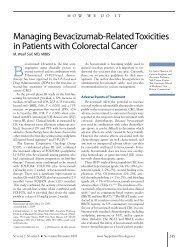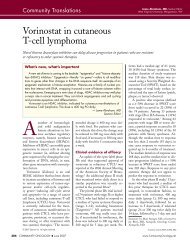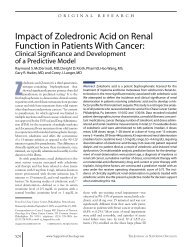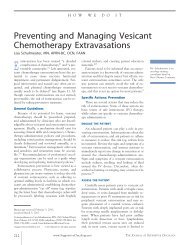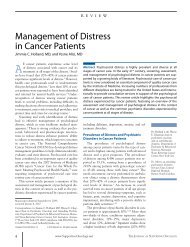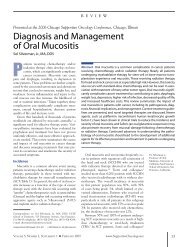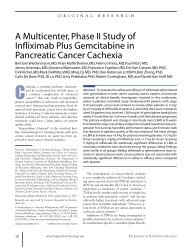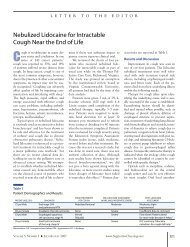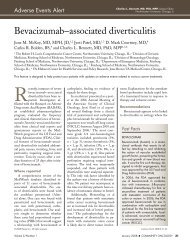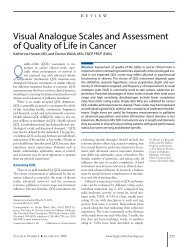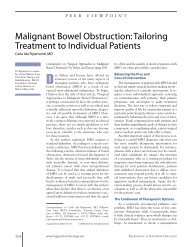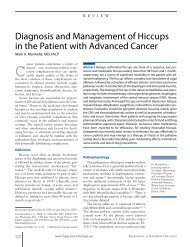Evaluating the “Good Death” Concept from Iranian Bereaved Family
Evaluating the “Good Death” Concept from Iranian Bereaved Family
Evaluating the “Good Death” Concept from Iranian Bereaved Family
Create successful ePaper yourself
Turn your PDF publications into a flip-book with our unique Google optimized e-Paper software.
Symptom Experience in Patients with Gynecological Cancers<br />
neuropathy is a difficult symptom to manage in practice and<br />
may necessitate dose reductions or chemo<strong>the</strong>rapy discontinuation;<br />
<strong>the</strong>refore, <strong>the</strong> development of management strategies<br />
for this symptom is imperative. Women complained of sleeping<br />
difficulties when <strong>the</strong>y experienced numbness and tingling<br />
sensations in <strong>the</strong>ir hands and feet, and it was a frustrating<br />
symptom that was also associated with depression. This is<br />
ano<strong>the</strong>r symptom cluster that merits fur<strong>the</strong>r research, and it is<br />
only emerging in <strong>the</strong> literature. Our past work on symptom<br />
clusters has also identified <strong>the</strong> presence of a “hand–foot”<br />
symptom cluster, which consistently increased over time and<br />
suggested a chronic nature, although not all symptoms identified<br />
in <strong>the</strong> present study were part of <strong>the</strong> latter quantitative<br />
evaluation. 24<br />
It was surprising to see <strong>the</strong> minimal range of interventions<br />
used to manage symptoms, both self-management and formal<br />
ones directed by <strong>the</strong> clinicians. The latter had minimal presence<br />
in <strong>the</strong> women’s descriptions, with <strong>the</strong> exception of pain<br />
management, antiemetics, and antidiarrheal medication. Specific<br />
physical responses to treatment were dealt with by<br />
changing <strong>the</strong> type of chemo<strong>the</strong>rapy and resorting to <strong>the</strong> use of<br />
herbal medicine for symptom management, such as echinacea<br />
and red clover, or o<strong>the</strong>r simple self-management techniques,<br />
such as soaking <strong>the</strong> feet in warm water, eating healthy food,<br />
and carrying out regular exercise. The use of complementary<br />
<strong>the</strong>rapies was also found in <strong>the</strong> study by Ferrell et al, 3 complementing<br />
<strong>the</strong> medical care provided to help control <strong>the</strong><br />
symptoms. 6 However, all of <strong>the</strong>se attempts seemed to be ad<br />
hoc, with no clear understanding of processes and possible<br />
outcomes or any guidance about <strong>the</strong>ir use <strong>from</strong> health-care<br />
professionals. Possible reasons for this ad hoc and unsatisfactory<br />
underutilization of symptom-management interventions<br />
may include <strong>the</strong> “acceptance” by patients that some symptoms<br />
are part of <strong>the</strong>ir treatment, <strong>the</strong> British cultural norm of<br />
not complaining, limited confidence <strong>from</strong> both clinicians and<br />
patients on nonpharmacological interventions with variable<br />
quality of evidence of effectiveness, distance <strong>from</strong> patients’<br />
homes to <strong>the</strong> specialist service to provide supportive care,<br />
limited understanding <strong>from</strong> <strong>the</strong> clinicians of <strong>the</strong> impact of<br />
symptoms on patients’ lives, and clinician time constraints.<br />
Although we purposely included women with a range of<br />
gynecological cancer diagnoses in order to gain an understanding<br />
of broadly applicable issues related to <strong>the</strong> physical<br />
and psychological symptom experiences of patients, <strong>the</strong> small<br />
References PubMed ID in brackets<br />
1. Johnson RL, Gold MA, Wyche KF. Distress<br />
in women with gynecologic cancer. Psychooncology<br />
2010;19:665–668.<br />
2. Petersen RW, Graham G, Quinlivan JA. Psychological<br />
changes after a gynaecologic cancer.<br />
J Obstet Gynecol Res 2006;31:152–157.<br />
3. Ferrell B, Smith S, Cullinane C, Melancon C.<br />
Symptom concerns of women with ovarian cancer.<br />
J Pain Symptom Manage 2003;25:528–538.<br />
4. Hipkins J, Whitworth M, Tarrier N, Jayson<br />
G. Social support, anxiety and depression after<br />
chemo<strong>the</strong>rapy for ovarian cancer: a prospective<br />
sample size limits <strong>the</strong> generalizability of <strong>the</strong> results. These<br />
symptom clusters will need fur<strong>the</strong>r evaluation with statistical<br />
modeling. Also, <strong>the</strong> existence of symptom clusters in radio<strong>the</strong>rapy<br />
may not have surfaced well in our study with <strong>the</strong><br />
inclusion of only three patients receiving radio<strong>the</strong>rapy, and<br />
this needs to be explored in future research. The length of<br />
treatment for each patient was variable, and knowledge of this<br />
would have enhanced <strong>the</strong> interpretability of <strong>the</strong> findings;<br />
however, this information was not available to us. Finally,<br />
although we wanted to focus on treatment-related symptoms,<br />
some of <strong>the</strong> symptoms (ie, anxiety and depression) may have<br />
multiple possible etiologies; and this needs to be considered in<br />
<strong>the</strong> interpretation of <strong>the</strong> findings.<br />
Conclusion<br />
Our study provides information on symptom experiences<br />
<strong>from</strong> <strong>the</strong> patients’ perspective, which could lead to a better<br />
understanding of how patients perceive, assess, monitor, and<br />
manage <strong>the</strong>ir symptoms. This is particularly useful as <strong>the</strong><br />
majority of <strong>the</strong> symptom literature focuses on <strong>the</strong> experience<br />
of patients with ovarian cancer. This is also important background<br />
information in developing strategies or interventions<br />
that are patient-centered and sensitive to <strong>the</strong> needs of patients<br />
that has relevance to <strong>the</strong> current policy framework. It<br />
also highlights <strong>the</strong> need for a more thorough patient assessment,<br />
to assess which symptoms are most bo<strong>the</strong>rsome and<br />
how symptoms are interrelated, and has implications for <strong>the</strong><br />
physiological, psychological, sociocultural, and behavioral<br />
components of <strong>the</strong> symptom experience essential for effective<br />
symptom management. While we have identified <strong>the</strong> presence<br />
and experience of some well-documented symptoms, we<br />
have also highlighted areas of importance for patients and<br />
some underreported symptoms that merit fur<strong>the</strong>r research in<br />
<strong>the</strong> future. Narrative symptom clusters, such as those identified<br />
in <strong>the</strong> present study, can provide a stronger conceptual<br />
basis in <strong>the</strong> symptom cluster modeling work and can assist in<br />
identifying patient-relevant and clinically meaningful groups<br />
of symptoms that can be <strong>the</strong> focus of future cluster research.<br />
Acknowledgments: Funding for this study, as part of a<br />
program grant on patient experiences of cancer symptoms,<br />
was obtained <strong>from</strong> <strong>the</strong> Christie Hospital Charitable Fund.<br />
Conflicts of interest: None to disclose.<br />
study. Br J Health Psychol 2004;9(pt 4):569–<br />
581.<br />
5. Williams PD, Piamjariyakul U, Ducey KA,<br />
Badura J, Boltz D, Olberding K, Wingate A, Williams<br />
AR. Cancer treatment, symptom monitoring,<br />
and self-care in adults. Cancer Nurs 2006;29:<br />
347–355.<br />
6. Donovan HS, Hartenbach EM, Method MW.<br />
Patient–provider communication and perceived<br />
control for women experiencing multiple symptoms<br />
associated with ovarian cancer. Gynecol<br />
Oncol 2005;99:404–411.<br />
7. Rosman S. Cancer and stigma: experience<br />
of patients with chemo<strong>the</strong>rapy-induced<br />
alopecia. Patient Educ Couns 2004;52:333–<br />
339.<br />
8. Hackbarth M, Haas N, Fotopoulou C, Lichtenegger<br />
W, Schouli J. Chemo<strong>the</strong>rapy-induced<br />
dermatological toxicity: frequencies and impact<br />
on quality of life in women’s cancer: results of a<br />
prospective study. Support Care Cancer 2008;16:<br />
267–273.<br />
9. Kayl AE, Meyers CA. Side-effects of chemo<strong>the</strong>rapy<br />
and quality of life in ovarian and breast<br />
70 www.SupportiveOncology.net THE JOURNAL OF SUPPORTIVE ONCOLOGY



